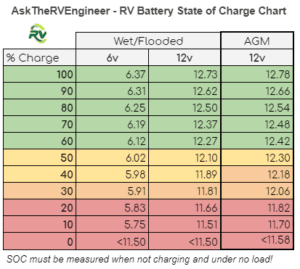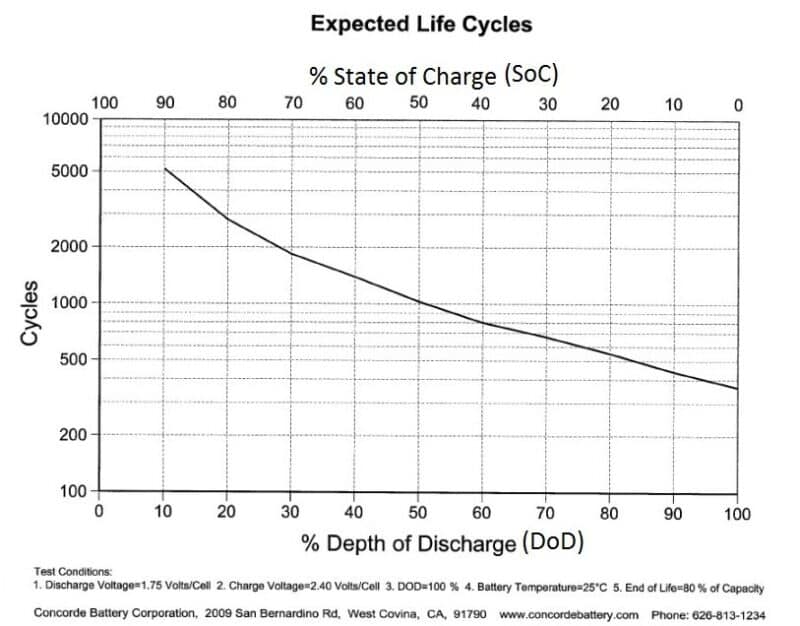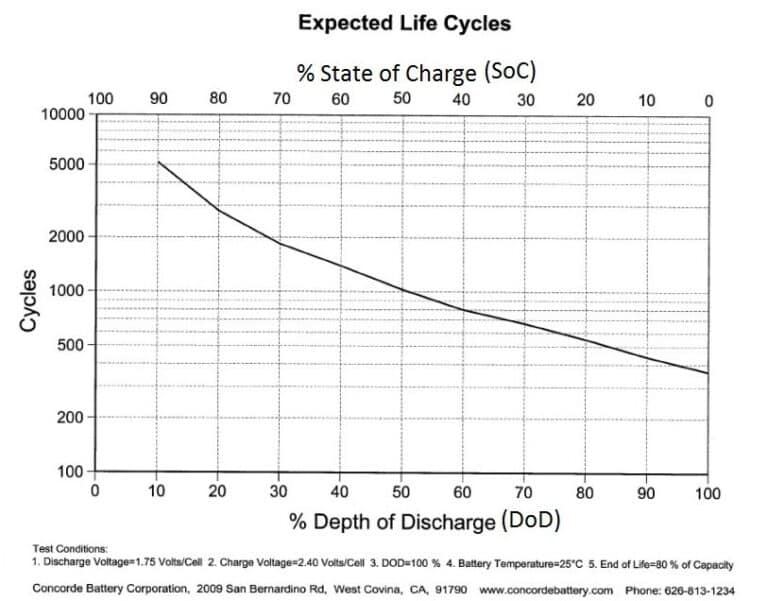If your RV house batteries are draining faster than you expected, you could be looking at several potential problems: a “soft short” in the wiring, a damage appliance, or general low-level parasitic loads.
Troubleshooting a dead or draining RV battery without a multimeter is pretty difficult, so I recommend you arm yourself with one BEFORE you continue with this article. You’ll need to be able to measure DC voltage, and it’s helpful if you can detect amp draw as well.
Before we get into the exact reasons why an RV battery is draining quickly, let’s go over some of the basics of RV battery science and connections.
How Does an RV Battery Charge?

RV batteries charge when a voltage is applied through a charger. Most modern battery charges are 3- or 4-stage chargers.
- Bulk: The charger outputs 14.2-14.6 volts to quickly recharge drained batteries. In this stage, the battery is quickly gaining power. The battery will input as many amps into the battery as the internal resistance will allow.
- Absorption: Once the battery reaches about 80% charge, the charger will hold the voltage constant and decrease the amperage. This prevents the battery from overheating and losing water. The absorption stage takes a looong time and continues until the battery is fully charged.
- Float: Also known as “trickle charging,” the float stage just keeps the fully charged battery topped off at about 13.2 to 13.6 volts depending on chemistry.
Battery science websites do an excellent job of describing how batteries work. Here’s an article on 3-stage charging from BatteryStuff.com. We could get into the nitty-gritty of sulfation and electrolysis, but who cares?
One last thing you should know: It’s healthiest for a lead-acid battery to be at full charge!
Why Is My RV Battery Dead?
So your battery has given up the ghost, pegged out, snuffed it, bought the farm, flatlined? And it’s probably happened at the worst possible time, hasn’t it?
Let’s take a page from Lazarus. Is it really dead? After all, you could say the battery is “dead” at any of these points!
- Your coach might not start with a battery at 9.8 volts, but your dashboard radio will work!
- Your batteries might read 12.7 volts at rest but drop to 10.5 volts under load.
So what really is “dead”?
Dead: Motorhome Is Not Starting!
My wife drives a red Honda Fit. It’s a cute, zippy hatchback with a big attitude but a small starter battery. It’s also guaranteed to die at least once every winter.
And by dies, I mean that the battery can’t power the starter motor long enough to turn over the engine. But when I hook up the battery to a charger, it still has 70-80 percent capacity! What gives?
Well, because the battery is so small, it needs to be at least 85-90 percent charged (or so I’ve found) to crank the engine. It’s not “dead” in a chemical sense, but we call it dead because it can’t perform its intended function.
Where Does This Problem Occur?
This problem typically shows up when the batteries are asked to perform a lot of work in a short amount of time. This is a common problem for RV starter batteries, used in motorhomes and vans. It can also pop up when you’re using an upgraded house battery bank plus an inverter to power big loads like air conditioners.
Dead: At Minimum Useable Capacity
As we’ll discuss later, you shouldn’t discharge a 12V battery to 0V, or 5V, or even 10.5V! Most deep-cycle lead-acid batteries shouldn’t be discharged to less than 12.0-12.25 volts!
If your brain’s reeling, check out this chart. It’s on a logarithmic scale, so pay close attention:

Let’s say you discharge your battery just to 80% of capacity. According to this chart, you’ll get 3,000 cycles out of it!
If you’re a full-time RVer, that’s more than 8 years! Wow! Awesome!
Now let’s say you have a smaller battery. You’re discharging down to 50%. How long will you last? Roughly 1,000 cycles.
That’s less than three years. Yeesh. The math is not working in your favor. Two batteries would cost twice as much but you’ll get almost three times more life total!
Now let’s suppose you ignored my advice, didn’t read this article and routinely discharged down to 20%.
How long will your battery last? About 500 cycles, or 16 months. You’ll be buying a new battery every other spring or fall!
So we might say the battery is “dead” at 30, 40 or 50% capacity. There’s still useable juice inside, but we can’t access it without degrading our battery’s lifespan.
Where Does This Problem Occur?
This problem is the most common across all RVs! It’s also the most nefarious because you don’t know it’s happening! Most systems will NOT alert you of the battery’s state-of-charge. If you’re dry camping for a weekend on a stock battery setup, it’s pretty easy to discharge your house batteries below 50% capacity.
Dead: The Battery Is at 0% State of Charge.

At 0% state of charge, most “12V” electrical components will no longer turn on or function properly.
Permanent electrical and mechanical damages will likely occur when a 12V lead-acid battery dips below 10.5 volts. The battery internals can’t take it. Even if the battery isn’t ruined, it will probably deliver less power when under load.
For this reason, and several others, you should not fully discharge a deep-cycle battery.
Dead: The Battery Cannot Be Recharged
At somewhere around 5V-7V (for most batteries), the battery has suffered irrevocable internal damage. There’s no magic electrical sauce that can bring it back. It’s physically broken, like a tree torn apart after a tornado. It’s ruined and forever will be.
Dead: No Voltage Remaining
The battery is well and truly dead: 0V. There’s not an ounce of energy left inside. This virtually NEVER happens unless 100% of the electrolyte boils out of the battery and it sits unattended for years.
Why Is My RV Battery Draining So Fast?
If your RV battery is draining too fast, you need to confirm it was fully charged. To do this, you either need a high-quality battery monitor or a voltmeter to measure its state of charge.
Don’t assume because you charged your battery to capacity last fall that it’s fully charged in the spring. Batteries self-discharge – aka, they lose power just sitting there. A high-quality AGM battery should only lose about 3% per month, though.
If you have a healthy battery that’s STILL draining way faster than expected, check out these five common problems:
Forgotten Lights
Check your headlamps, dome lights, undercabinet lights, etc. Incandescent lights can drain a battery in a matter of hours. LED lights are much more energy-efficient.
Connected to Tow Vehicle
Under certain circumstances, you can drain your camper battery from your tow vehicle. If A) you don’t have an inline battery isolator and B) you’re drawing power from your tow vehicle battery – say, playing the radio – then you can accidentally discharge your camper battery at the same time.
Fridge on Battery Power
Here’s a dirty secret: The typical 3-way RV fridge draws an INCREDIBLE amount of power on 12V DC operation. You can drain a fully charged battery in 30-40 minutes in cooling mode.
Some people like to blame the CO2 detector, but it hardly slurps up any power. Don’t deactivate a critical safety device just to save a fraction of an amp. Your life isn’t worth it.
How Long Will My RV Battery Last?

The life of an RV battery can be measured in years or cycles.
There are three big factors deciding battery life:
- Has the battery been kept out of extreme heat and humidity?
- Has the battery only been discharged 20-50% of capacity?
- Has the battery been kept at full charge when not in use?
If properly cared for, a deep-cycle battery can last* 4-5 years. In a controlled environment, such as a solar panel battery bank in a warehouse, a battery can last twice as long. But in extreme environments, like Arizona summers, a battery might only 1-3 years.
By last, I mean it retains all or most of its original charge capacity. When a battery loses more than 15-20% of its capacity, it’s time to replace it.
Will My RV Battery Run the A/C?
Funny you should ask! I wrote a whole article about this question. You can read it here.
The crux of the problem is that air conditioners draw a tremendous amount of power, and RV house batteries simply don’t contain enough power. There is no magic inverter or component that will change this.
If you attempt to run your RV A/C off the battery, you’d empty the battery in 5-20 minutes of operation. More than likely, your battery would be irreparably damaged, too.
A battery bank large enough to run an RV rooftop A/C would weigh several hundred pounds, require hours to charge, cost many thousands of dollars. Basically, your choice is either to run your RV A/C off a battery bank or pay for your child’s college fund.
Will My RV Battery Run the Fridge?

This answer … is a little tricky. Most RVs are equipped with 3-way refrigerators that can operate on LP, 12V, and 120V power.
“Awesome!” you say. “I can use any form of power available nearby!”
That’s just sales talk. Unless you’re running a true 12V compressor fridge, typically only found in higher-end luxury and off-road models, the 12V-only operation is nigh useless.
Most 3-way fridges will draw 12-20 amps per hour on 12V-only operation. In 2-4 hours in cooling mode, you’ll drain your battery to its recommended 50% capacity.
If you want to know your reefer’s draw, check out the manufacturer’s model information. Chances are it’s made by either Dometic or Norcold.
If you’re thinking, “My tow vehicle will just charge my battery while I drive!” I have bad news for you. First, batteries don’t discharge and charge at the same time. Second, your tow vehicle won’t put out enough power to run your fridge.
Again, dedicated 12V compressor fridges are an exception. These ultra-efficient models might only draw 2-5 amps!
Will My RV Battery Run the Furnace?
Yes … but the clock’s ticking. Your average RV gas-powered furnace draws 2-5 amps at 12V for the control board and blower motor. Let’s see how the math plays out.
If you have a 100-Ah deep-cycle battery and a furnace that draws 4A at 12V, how much power is left over after an 8-hour night’s sleep?
You’d use up 36-Ah out of 50 useable. Add a little bit of power for lights and control boards, and chances are you won’t last more than a single night running a furnace.
Leave a Reply